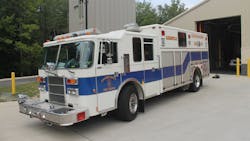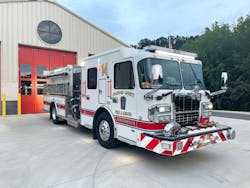Lighting is an often-overlooked tool, but it significantly improves safety on the fireground. How many apparatus operators fire up vehicle-mounted scene lights as they pull up to get a better view at a nighttime incident and to provide lighting for crews? The answer should be 100 percent.
Apparatus operators should demand and plan for good scene lighting. In the same vein, they should help to set up portable lighting, too, as needed.
Vehicle-mounted lights
When specifying apparatus lighting, bigger isn’t always better. Leaving light towers out of the discussion at this time (so much can be discussed about it alone), let’s focus on what is used when you arrive on scene.
Some basics of apparatus scene lighting to consider include: Can the lighting be fired up as the apparatus moves and approaches the scene to help to illuminate the address? Is there lighting on all four sides of the apparatus, which provides options for focusing the lighting wherever needed, and can it be controlled from the officer’s and driver’s position? (Remember to keep lighting focused downward so as not to blind responders and anyone who is traveling through or working in the area.) Is the lighting a mixture of flood and spot lighting (so not only the area around the apparatus can be lit but also areas that are away from the apparatus, such as the front of structures and at scene work areas)? Can the lighting be adjusted, including to provide downward lighting for work close to the apparatus? Can the lighting focus and height be changed (telescoping lights), and, if so, what is required/how accessible is it to make those changes?
Even with the answers to these questions, you would be remiss to finalize any apparatus specifications in regard to lighting without consulting NFPA 1901: Standard for Automotive Fire Apparatus. The standard has a dedicated section that covers numerous facets of scene lighting.
Portable lighting
When specifying apparatus, it isn’t surprising that vehicle-mounted scene lighting is considered in great detail, but let’s face it, you will need to light the inside of structures and other remote locations on the fireground, and not all vehicle accidents happen on the roadway. So, how do you provide lighting in a remote area or in a building that can’t be illuminated via apparatus lighting and tethered lighting?
Portable lighting must be thought through with the same intensity, so to speak, that’s applied to vehicle-mounted scene lighting. For example, how antiquated is the portable lighting in comparison with today’s newest high-output units?
If you have preconnected cord reels, how long are they? At least one should be at least as long as your longest preconnected hoseline. Further, survey your district and look at response needs to identify cord reel lengths that are needed. A note of caution: Too much cable can be a recipe for tangle when coming on or off of the cable reel.
Are the reels marked or color-coded for lengths? How accessible are the reels for maintenance, etc.? Are the reels easily accessible to correct tangles, etc., when deploying or storing the cable? In other words, can the reels be accessed easily via a compartment door, or do you have to remove a panel or two to gain access? Another thought: Make sure that you don’t store equipment around the cord reels, which could hang up the cable. Rollers that have guides that are on compartment doors will help to eliminate snags.
Is there a junction box that has a work light attached, or must you go to another compartment to get to the junction box and then connect the light? How many outlets are on your apparatus and cord reel boxes to support lighting? My personnel belief and input from officers, operators and firefighters indicates that, at minimum, outlets should be on each of the four sides of a vehicle. Remember, though, you need to be able to supply and support your load demand.
Whether portable lighting is rig-mounted or tethered, you must ensure that your generator is set up to power the lighting devices that you carry and have mounted on the rig as well as has some room to grow.
Two great tools that have proven themselves time and time again are the small portable generator and the small portable generator that has scene lights that are mounted on it, both of which are produced by several manufacturers.
Among the factors about a portable generator to consider, the most critical is its power rating. You must ensure that the generator that you purchase has enough capacity to power the needs that you have defined for your response district.
Before you can calculate your needs, you must understand starting wattage, running wattage and surge wattage. The wattage or power that your portable generator must produce will depend on the quantity and type of items or equipment that you want to run. Running wattage is the amount of electricity that’s required to keep the device running. Starting wattage is the amount of electricity that’s required to start the device running. On average, the amount of power that’s required to start a device usually is three times the amount that’s needed to keep the device running. Surge wattage is the most power that you can get from your generator.
Now you can define the electrical load that you are planning for the unit but leave some room for future growth. Most generator manuals and lighting equipment manuals include examples of what kinds of devices that they can provide power for and what the individual equipment requirements are, respectively. You also can calculate it yourself for smaller needs using the following formula. Identify the device for which you want to provide power. Check the device’s owner’s manual to determine how much wattage that the device requires. Multiply the running wattage of the device by three. Add the running wattage to the starting wattage for the total wattage that the device requires.
A good rule of thumb is to always use a generator that can comfortably handle all of your power needs while using no more than 90 percent of its capacity. When specifying a portable generator, I prefer a minimum of 2,000 watts, particularly if a light head is attached to the generator. Of course, there is a cost of additional weight. Most 1,000-watt units weigh in about 25–30 lbs., and 2,000-watt units are in the 45–50-lb. range.
Don’t forget, if the generator that you are considering has an attached light head, include that light’s output in the operating load.
Another important factor that must be considered: Is the portable generator capable of supplying “clean power,” or in other words, are sensitive electronic items protected from being damaged?
Portability also is a high priority when purchasing a portable generator. Consider where the portable generator will be operating and how easily that you can get it to where it is needed. Can one person deploy it? Unit weight and carrying handles come into play here. For me, if the weight exceeds 50 lbs., you lose the advantage of portability. As far as handles go, I prefer ones that are molded onto the body of the unit. Also important: Can you get a gloved hand through the handle easily and comfortably.
Other factors must be considered before the purchase of a portable generator, too. (See “Portable Generator Specs” sidebar.)
In my department’s experience, portable generators that are manufactured by Honda have performed well. Particularly appealing are the manufacturer’s Eco-Throttle System, which aids in fuel efficiency; Honda’s inclusion of inverter technology to stabilize power in conjunction with the use of computers and other electronic devices; and a healthy supply of third-party LED light heads that can be used with some of the Honda models.
Speaking of LED lighting, the technology continues to evolve in impressive ways, and when it’s coupled with newer rechargeable battery power sources, it has the capability to illuminate to an extent that previously wasn’t possible. The load that’s placed on apparatus and generator electrical systems is reduced, too, not to mention the generation of better, cleaner light.
Don’t forget about portable battery-powered lighting, such as large rechargeable handheld lanterns, including Streamlight’s LiteBox lanterns or one of the rechargeable portable work lights on a stand/pole, or tripod lights, that pack a million-candle power or more. The latter are excellent for use in buildings and all-over incident scenes, mainly where you have to illuminate a wide area.
Determining needs
How does a department know whether its current basic scene lighting or lighting that it’s considering for purchase provides a good start to light a work area on arrival? To evaluate the effectiveness of equipment and to plan for the future, talk to your members and see where they believe that there were lighting issues at calls in various situations and types. From our department’s review of photographs and discussions with members, when we replaced a ladder truck, we included ladder-tip work lighting to assist the operator with working the scrub area. Scene lighting on all four sides of the apparatus was very important in the rural areas that we serve from a size-up, operations and safety standpoint.
Also, set up your lighting during training and see what you notice as far as dark areas and limitations on lighting equipment.
The adage, “A picture is worth a thousand words,” applies, too. Review photographs and video from trainings and incidents.
From a roadway-response standpoint, it can be very helpful to have someone drive through the work zone area to encounter the lighting from a driver’s perspective. Even better, if available, have that person activate the dashcam to record it for review.
Finally, don’t forget about maintenance. Keep lights clean, make sure that their housings are weathertight and, as with any electrical item, check the cords, receptacles and circuit breakers to confirm that they are functioning properly. Make sure that the charging systems of rechargeable units work properly. Again, don’t forget to mark your cord reels with the length, and make sure that you have the proper adapters attached or handy for the lights. Confirm that the fuel is fresh in generators.
Portable Generator Specs
A lthough a portable generator’s power rating, its capability to operate electronic devices safely and its portability are its most important features/functions in regard to fire service use, other factors should be considered, too.
- Noise output: A quieter unit is a plus, particularly if the unit must be deployed in an area where crews are working and must communicate
- Built-in overload protection: This is a must for the fire service; make sure that circuit breakers protect the outlets to prevent overloading and equipment damage
- Fuel tank size: Larger isn’t better necessarily; remember, this is a portable unit; furthermore, after you purchase a portable generator, verify run times on a tank of fuel under load, so you don’t get caught running out when on scene
About the Author
Allen Baldwin
Allen Baldwin started his fire service career in Wilkins Township, PA, while he was in high school. He currently serves as the assistant fire and EMS chief, operations command, for the Stafford County, VA, Fire and Rescue Department. Baldwin holds a master’s degree in organizational leadership from Waldorf University, a bachelor’s degree in public administration from Point Park University and an associate degree in fire science from the Community College of Allegheny County.

